北师大版(2019)必修 第三册Unit 8 Green Living Writing Workshop A Survey Report 教学设计(表格式)
文档属性
| 名称 | 北师大版(2019)必修 第三册Unit 8 Green Living Writing Workshop A Survey Report 教学设计(表格式) | 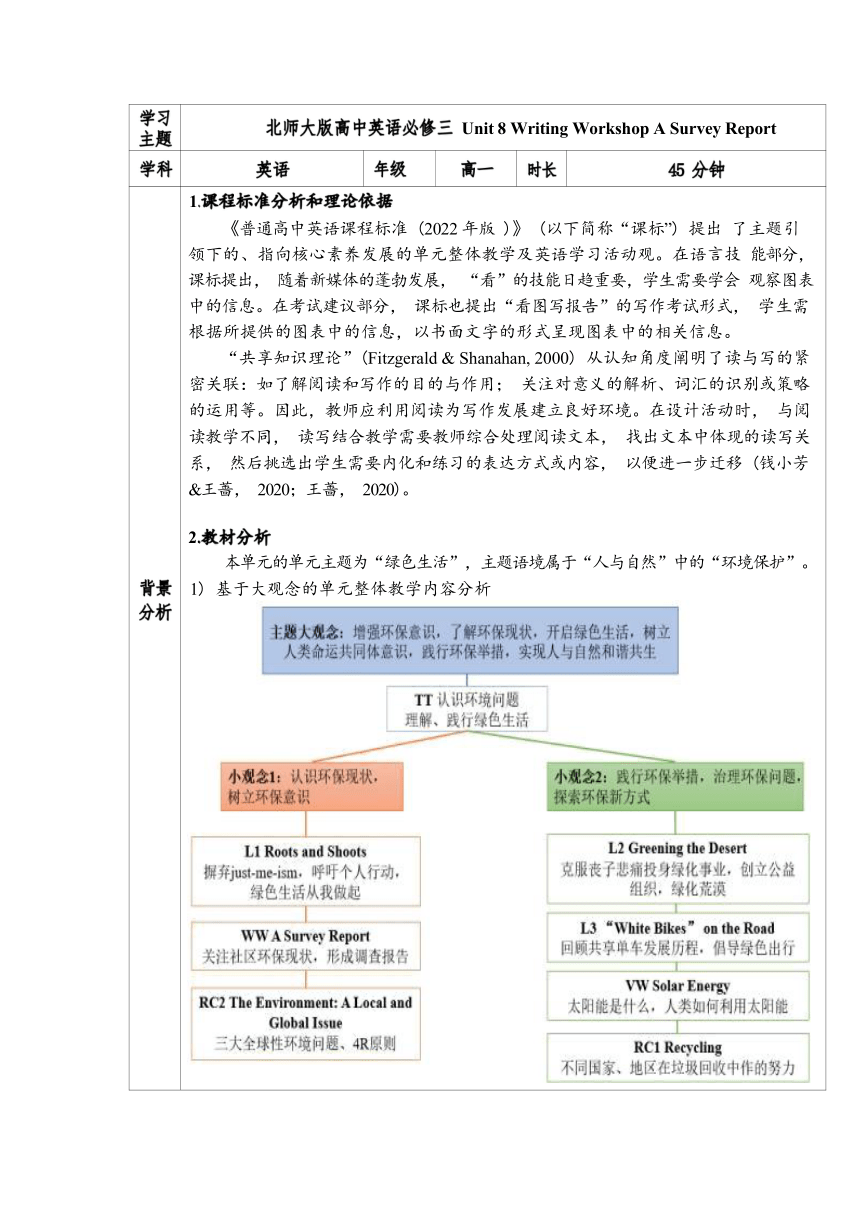 | |
| 格式 | docx | ||
| 文件大小 | 1.0MB | ||
| 资源类型 | 教案 | ||
| 版本资源 | 北师大版(2019) | ||
| 科目 | 英语 | ||
| 更新时间 | 2025-01-27 16:54:46 | ||
图片预览

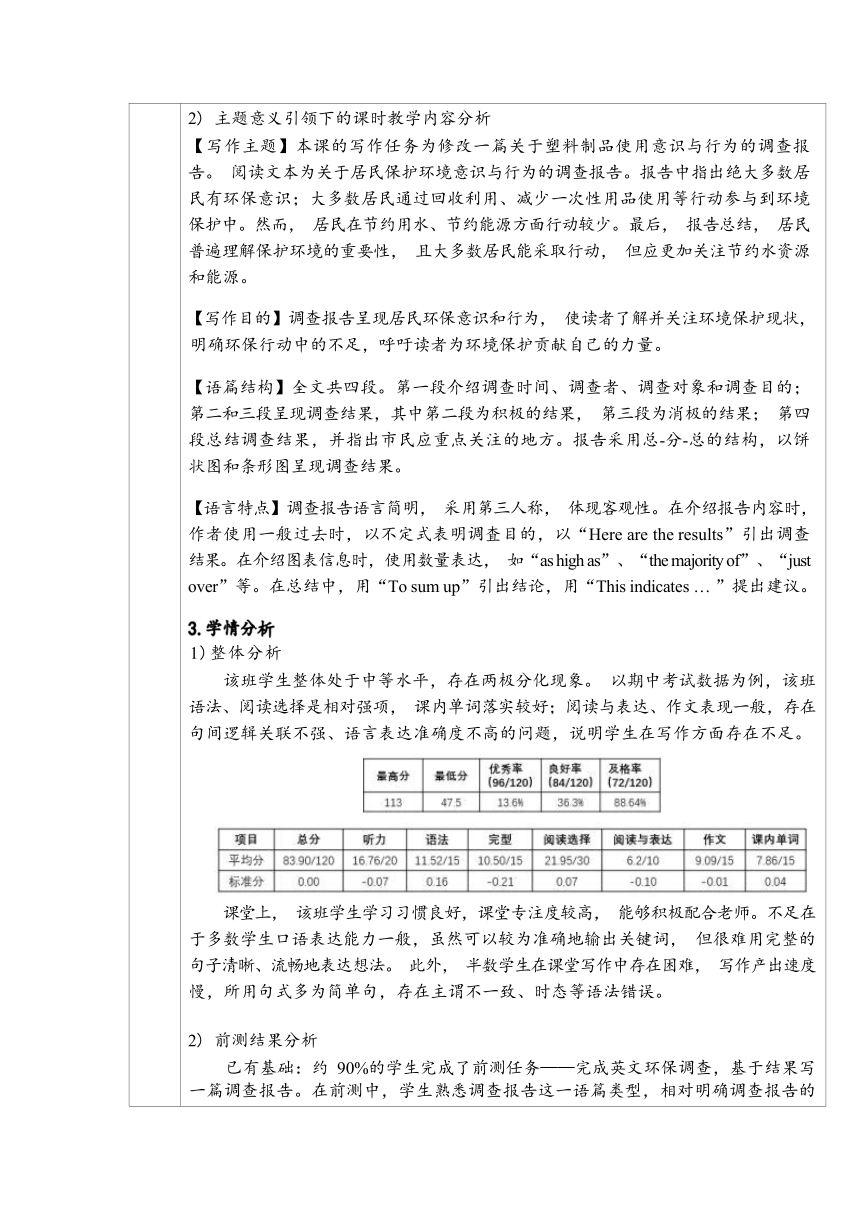
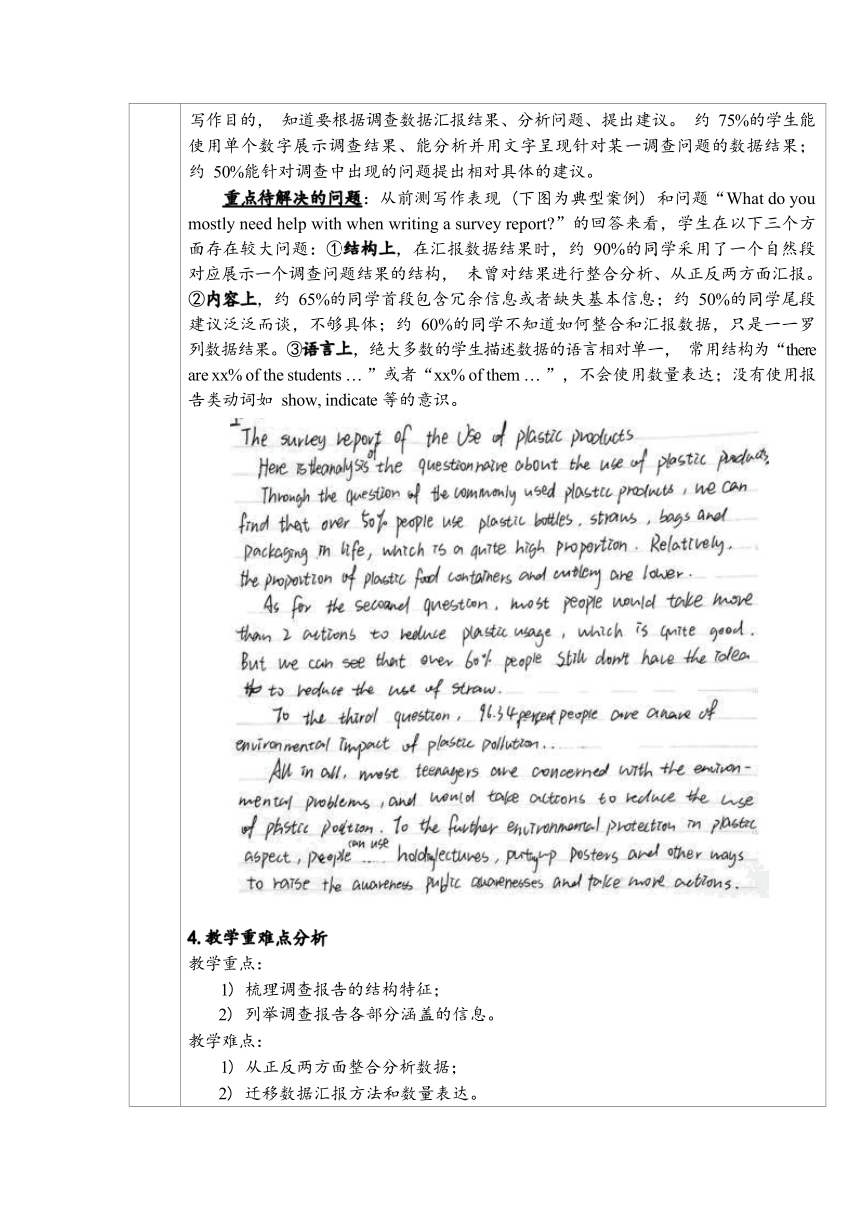
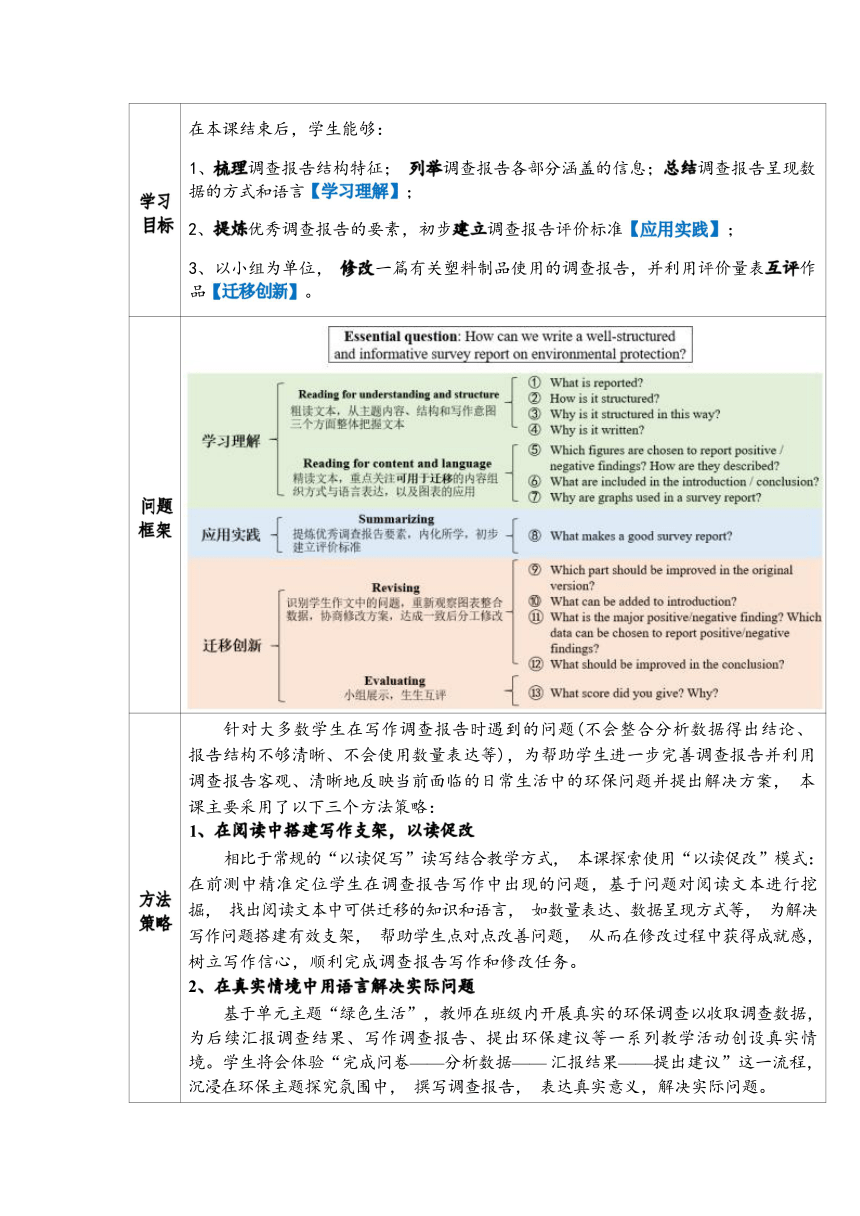
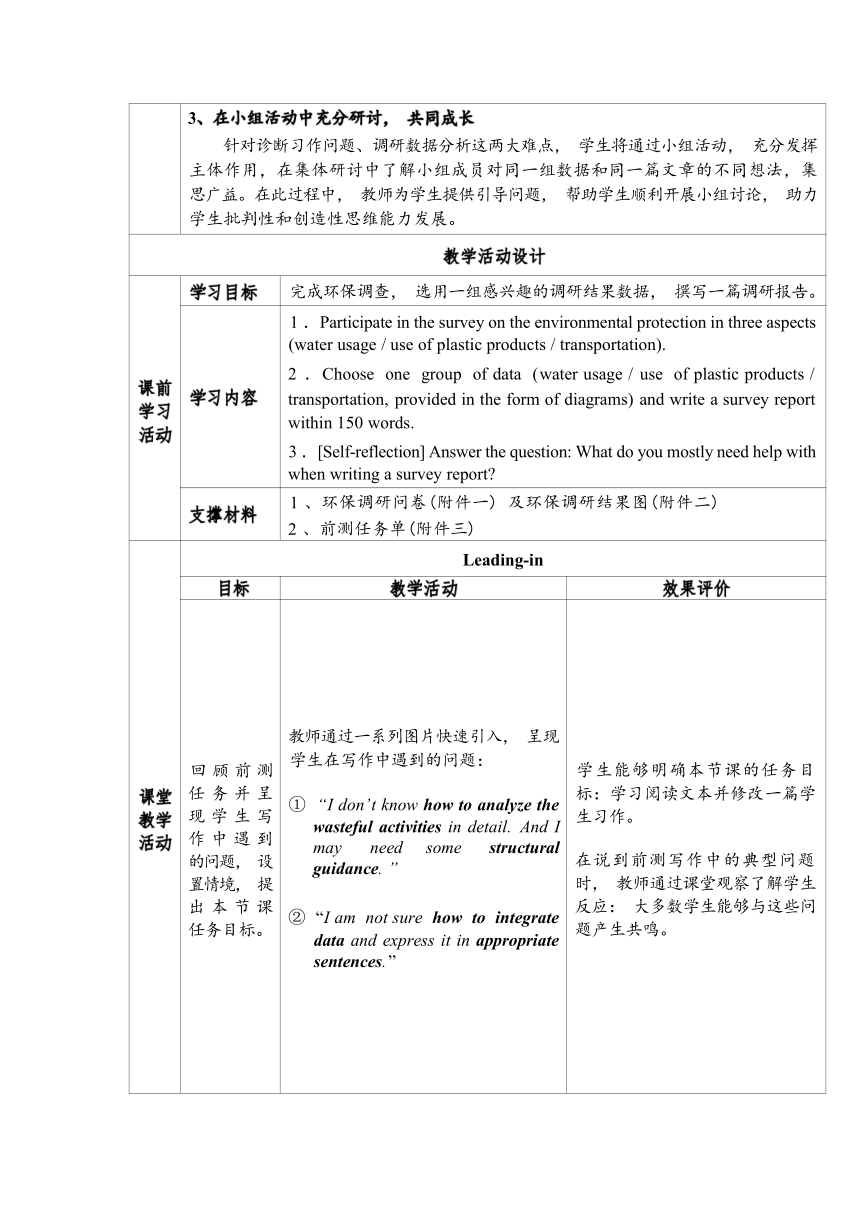
文档简介
学习 主题 北师大版高中英语必修三 Unit 8 Writing Workshop A Survey Report
学科 英语 年级 高一 时长 45 分钟
背景 分析 1.课程标准分析和理论依据 《普通高中英语课程标准 (2022 年版 )》 (以下简称“课标”) 提出 了主题引领下的、指向核心素养发展的单元整体教学及英语学习活动观。在语言技 能部分, 课标提出, 随着新媒体的蓬勃发展, “看”的技能日趋重要,学生需要学会 观察图表中的信息。在考试建议部分, 课标也提出“看图写报告”的写作考试形式, 学生需根据所提供的图表中的信息,以书面文字的形式呈现图表中的相关信息。 “共享知识理论”(Fitzgerald & Shanahan, 2000) 从认知角度阐明了读与写的紧 密关联:如了解阅读和写作的目的与作用; 关注对意义的解析、词汇的识别或策略 的运用等。因此,教师应利用阅读为写作发展建立良好环境。在设计活动时, 与阅 读教学不同, 读写结合教学需要教师综合处理阅读文本, 找出文本中体现的读写关 系, 然后挑选出学生需要内化和练习的表达方式或内容, 以便进一步迁移 (钱小芳 &王蔷, 2020;王蔷, 2020)。 2.教材分析 本单元的单元主题为“绿色生活”,主题语境属于“人与自然”中的“环境保护”。 1) 基于大观念的单元整体教学内容分析
2) 主题意义引领下的课时教学内容分析 【写作主题】本课的写作任务为修改一篇关于塑料制品使用意识与行为的调查报 告。 阅读文本为关于居民保护环境意识与行为的调查报告。报告中指出绝大多数居 民有环保意识;大多数居民通过回收利用、减少一次性用品使用等行动参与到环境 保护中。然而, 居民在节约用水、节约能源方面行动较少。最后, 报告总结, 居民 普遍理解保护环境的重要性, 且大多数居民能采取行动, 但应更加关注节约水资源 和能源。 【写作目的】调查报告呈现居民环保意识和行为, 使读者了解并关注环境保护现状, 明确环保行动中的不足,呼吁读者为环境保护贡献自己的力量。 【语篇结构】全文共四段。第一段介绍调查时间、调查者、调查对象和调查目的; 第二和三段呈现调查结果,其中第二段为积极的结果, 第三段为消极的结果; 第四 段总结调查结果,并指出市民应重点关注的地方。报告采用总-分-总的结构,以饼 状图和条形图呈现调查结果。 【语言特点】调查报告语言简明, 采用第三人称, 体现客观性。在介绍报告内容时, 作者使用一般过去时,以不定式表明调査目的,以“Here are the results”引出调查 结果。在介绍图表信息时,使用数量表达, 如“as high as”、“the majority of”、“just over”等。在总结中,用“To sum up”引出结论,用“This indicates … ”提出建议。 3.学情分析 1)整体分析 该班学生整体处于中等水平,存在两极分化现象。 以期中考试数据为例,该班 语法、阅读选择是相对强项, 课内单词落实较好;阅读与表达、作文表现一般,存在 句间逻辑关联不强、语言表达准确度不高的问题,说明学生在写作方面存在不足。 课堂上, 该班学生学习习惯良好,课堂专注度较高, 能够积极配合老师。不足在 于多数学生口语表达能力一般,虽然可以较为准确地输出关键词, 但很难用完整的 句子清晰、流畅地表达想法。 此外, 半数学生在课堂写作中存在困难, 写作产出速度 慢,所用句式多为简单句,存在主谓不一致、时态等语法错误。 2) 前测结果分析 已有基础:约 90%的学生完成了前测任务——完成英文环保调查,基于结果写 一篇调查报告。在前测中,学生熟悉调查报告这一语篇类型,相对明确调查报告的
写作目的, 知道要根据调查数据汇报结果、分析问题、提出建议。 约 75%的学生能 使用单个数字展示调查结果、能分析并用文字呈现针对某一调查问题的数据结果; 约 50%能针对调查中出现的问题提出相对具体的建议。 重点待解决的问题:从前测写作表现 (下图为典型案例) 和问题“What do you mostly need help with when writing a survey report ”的回答来看,学生在以下三个方 面存在较大问题:①结构上,在汇报数据结果时,约 90%的同学采用了一个自然段 对应展示一个调查问题结果的结构, 未曾对结果进行整合分析、从正反两方面汇报。 ②内容上,约 65%的同学首段包含冗余信息或者缺失基本信息;约 50%的同学尾段 建议泛泛而谈,不够具体;约 60%的同学不知道如何整合和汇报数据,只是一一罗 列数据结果。③语言上,绝大多数的学生描述数据的语言相对单一, 常用结构为“there are xx% of the students … ”或者“xx% of them … ”,不会使用数量表达;没有使用报 告类动词如 show, indicate 等的意识。 4.教学重难点分析 教学重点: 1) 梳理调查报告的结构特征; 2) 列举调查报告各部分涵盖的信息。 教学难点: 1) 从正反两方面整合分析数据; 2) 迁移数据汇报方法和数量表达。
学习 目标 在本课结束后,学生能够: 1、梳理调查报告结构特征; 列举调查报告各部分涵盖的信息;总结调查报告呈现数 据的方式和语言【学习理解】; 2、提炼优秀调查报告的要素,初步建立调查报告评价标准【应用实践】; 3、以小组为单位, 修改一篇有关塑料制品使用的调查报告,并利用评价量表互评作 品【迁移创新】。
问题 框架
方法 策略 针对大多数学生在写作调查报告时遇到的问题(不会整合分析数据得出结论、 报告结构不够清晰、不会使用数量表达等),为帮助学生进一步完善调查报告并利用 调查报告客观、清晰地反映当前面临的日常生活中的环保问题并提出解决方案, 本 课主要采用了以下三个方法策略: 1、在阅读中搭建写作支架,以读促改 相比于常规的“以读促写”读写结合教学方式, 本课探索使用“以读促改”模式: 在前测中精准定位学生在调查报告写作中出现的问题,基于问题对阅读文本进行挖 掘, 找出阅读文本中可供迁移的知识和语言, 如数量表达、数据呈现方式等, 为解决 写作问题搭建有效支架, 帮助学生点对点改善问题, 从而在修改过程中获得成就感, 树立写作信心,顺利完成调查报告写作和修改任务。 2、在真实情境中用语言解决实际问题 基于单元主题“绿色生活”,教师在班级内开展真实的环保调查以收取调查数据, 为后续汇报调查结果、写作调查报告、提出环保建议等一系列教学活动创设真实情 境。学生将会体验“完成问卷——分析数据—— 汇报结果——提出建议”这一流程, 沉浸在环保主题探究氛围中, 撰写调查报告, 表达真实意义,解决实际问题。
3、在小组活动中充分研讨, 共同成长 针对诊断习作问题、调研数据分析这两大难点, 学生将通过小组活动, 充分发挥 主体作用,在集体研讨中了解小组成员对同一组数据和同一篇文章的不同想法,集 思广益。在此过程中, 教师为学生提供引导问题, 帮助学生顺利开展小组讨论, 助力 学生批判性和创造性思维能力发展。
教学活动设计
课前 学习 活动 学习目标 完成环保调查, 选用一组感兴趣的调研结果数据, 撰写一篇调研报告。
学习内容 1 .Participate in the survey on the environmental protection in three aspects (water usage / use of plastic products / transportation). 2 .Choose one group of data (water usage / use of plastic products / transportation, provided in the form of diagrams) and write a survey report within 150 words. 3 .[Self-reflection] Answer the question: What do you mostly need help with when writing a survey report
支撑材料 1 、环保调研问卷(附件一) 及环保调研结果图(附件二) 2 、前测任务单(附件三)
课堂 教学 活动 Leading-in
目标 教学活动 效果评价
回 顾 前 测 任 务 并 呈 现 学 生 写 作 中 遇 到 的问题, 设 置情境, 提 出 本 节 课 任务目标。 教师通过一系列图片快速引入, 呈现 学生在写作中遇到的问题: ① “I don’t know how to analyze the wasteful activities in detail. And I may need some structural guidance. ” ② “I am not sure how to integrate data and express it in appropriate sentences.” 学生能够明确本节课的任务目 标:学习阅读文本并修改一篇学 生习作。 在说到前测写作中的典型问题 时, 教师通过课堂观察了解学生 反应: 大多数学生能够与这些问 题产生共鸣。
Stage 1: Reading for Writing
目标 教学活动 效果评价
基 于 阅 读 文本,梳理 调 查 报 告 结构特征; 列 举 调 查 报 告 各 部 分 涵 盖 的 信息; 总结 调 查 报 告 呈 现 数 据 的 方 式 和 语言。 Read for Understanding and structure 学生阅读文本并回答四个问题: 1. What is reported 2. How is it structured (Refer to Ex.3 on p.41) 3. Why is it structured in this way 4. Why is it written 教师引导总结第一条写作建议: The structure must serve the writing purpose. Read for Content and Language 【Findings】学生先看调查报告中的 发现部分,回答以下两个问题: 1. Which figures are chosen to report positive / negative findings 2. How are they described 教师引导总结第二条写作建议: How to choose and describe the data: a). use quantity expressions, b). major findings + supporting figures, c). present the most significant results (high-level / low-level data) first. Read for Understanding and structure 学生能够准确回答出第 1 、2 、4 个问题: 1. People’s attitudes to protecting the environment and what actions they had taken. 2. Para. 1-Introduction; Para.2-Positive findings; Para.3- Negative finding; Para.4-Conclusion 4. To show the findings and call on more people to take part in environmental protection. 在教师引导下,学生能建立结构 和写作目的之间的关系,进而回 答问题 3——The structure must serve the writing purpose. Read for Content and Language 【Findings】学生能回答出: Positive findings: 96%, 4%, 88%, 74%, 70% Negative findings: 51%, 38% 并定位、分析这些数据在文中的 表达。 学生能观察教师高亮的文字内 容,在同伴研讨、师生对话的过 程中习得建议 b)和建议 c)。
提炼优秀 调查报告 的要素, 初步建立 调查报告 评价标 准。 【Introduction & Conclusion】学生借 助学案 (附件四) 提示, 阅读报告中 的介绍和总结部分, 列举出其中所涵 盖的细节信息。 在总结部分,教师引导学生详细分 析每一句话,明确调研发现的总结 方法。 【Graphs】教师再次呈现范文中的图 表,学生回答问题:Why are graphs used in a survey report 教师引导总结第三条写作建议: Use graphs to make complex data more accessible for readers. Summary 学生回答问题“What makes a good survey report ”,教师呈现 evaluation sheet (详见附件四),完善调查报告 评价标准。 【Introduction & Conclusion】学 生能在文本中定位相关信息。 学生能在教师引导下,注意到阅 读文本总结调研结果的方法:整 合调研问题, 分别总结积极结果 和消极结果,不使用具体数据。 【Graphs】学生能说出 to provide details / data 或 to make it clearer 等答案。 Summary 学生能说出 structure / four parts, use dada properly, use quantity expressions 等要点。
Stage 2: Revising
目标 教学活动 效果评价
以小组为 单位, 修 改一篇有 关塑料制 品使用的 调查报 告。 【阶段一】 学生以 8 人为一个小组, 共同阅读一 篇学生习作,找出问题所在;重新整 合、分析一组课前调研数据( 以 Use of plastic products) 为例,大致确定 各部分内容。 Guiding questionsfor discussion: 1. Which part should be improved in the original version 2. [Introduction] What can be added to introduction 3. [Findings] Focus on the data, what is the major positive/negative finding Which data can be chosen to report positive/negative findings 4. [Conclusion] What should be included in the summary of the findings What recommendations on “actions” would you like to add 【阶段二】 学生以小组为单位修改问题文章,八 人组自由拆分为四小对, 每两人负责 一个部分的修改工作。修改完毕后, 学生将各自修改好的部分粘贴在一 张海报上。 【阶段三】 学生在小组内推选一名同学展示本 组作品。 【阶段一】 学生能够利用引导问题,和同伴 一起发现习作中的问题: 介绍部分太短, 缺乏关键信息 发现部分 没有从正反两方面呈现 没有主要发现 数量表达较少 结论部分缺乏对负面结果的 总结,行动建议不够具体 学生能针对以上问题,在小组内 重新分析数据、充分讨论并提出 改进建议,确保全组成员达成一 致。 【阶段二】 学生能够合理分工并结合第一阶 段的讨论重写自己所负责的部 分。
Stage 3: Presenting and Evaluating
目标 教学活动 效果评价
展示修改 后的调研 报告,并 利用评价 量表互评 作品。 学生展示本组作品,其他同学根据 评价量表 (详见附件四) 打分和反 馈。 学生能根据评价量表,给其他小 组的报告打分,并从结构、内 容、语言三个方面口头点评。
板书设计
课后 作业 学习目标 修改课前所写的调研报告,并依据写作评价量表进行自评和互评。
作业要求 1. Revise your own survey report based on what you have learned today. 2. Use the evaluation sheet to make a self-assessment and a peer-assessment of the revised version.
支撑材料 1. 环保调研结果图(附件二) 2. 课后作业任务单(附件五)
技术 融合 数 字 技 术 融合点 问卷星在线调查问卷、图表制作和数据展示、 AI 赋能语言支持
使 用 描 述 及 使 用 的 意图 1. 问卷星在线调查问卷:在课前学习活动中, 教师通过问卷星网站制 作并发布英语环保调查, 为后续汇报调查结果、写作调查报告、提 出环保建议等一系列教学活动创设了真实情境。 2. 图表制作和数据展示:教师使用问卷星制作调查结果图表, 作为写 作数据来源发布给学生, 帮助学生在数据分析过程中更直观地理解 复杂的数据,锻炼“看”的技能, 同时也教会学生在自己的写作中 使用图表,为读者提供数据来源。
3. AI 赋能语言支持:教师通过命令 AI 分析数据结果、写作调查报告、 整理调查报告常用语言, 建立基于真实环保调查的写作预期, 从 AI 输出的内容中寻找可以提供给学生的语言支持, 拓展课本语言, 丰 富学生表达。
课程 思政 课程思政 元素 环境保护、道德与价值观教育、合作与责任感、批判性思维与问题解决 能力
融入过程 本课通过隐性的课程思政教育,提升了学生的必备品格和关键能 力,促进学生核心素养的发展: 1. 环保保护:本课围绕环保主题展开, 通过调查报告的形式让学生关 注水资源使用、塑料制品使用、交通等环境保护问题。这不仅提升 了学生的写作能力, 还增强了他们的环保意识, 体现了环境保护这 一重要的课程思政元素。 2. 道德与价值观的教育:通过探讨环境保护等道德和社会责任问题, 本课渗透了对学生道德观和价值观的教育, 引导他们在学习知识的 同时,培养正确的价值观和社会责任感。 3. 合作与责任感:本课强调小组合作, 通过集体讨论和修改调查报告, 培养学生的团队合作能力和责任感。这种合作学习模式有助于学生 认识到团队合作在实际工作中的重要性, 同时培养他们的集体责任 感和团队精神。 4. 批判性思维与问题解决能力:本课鼓励学生批判性思考,学生需要 通过阅读范文、分析结构、选择和描述数据来解决调查报告写作中 遇到的问题,提高了他们的分析和解决问题的能力。
附件一 环保调研问卷
Attitudes and Actions on Environmental Protection
This survey is designed to find out your attitudes to protecting the environment and what actions you taken in daily life. lt will focus on three aspects, water usage, use of plastic products and transportation.
Water usage
1. How often do you turn off the tap(水龙头) while brushing your teeth or taking a shower
Always
Sometimes
Never
2. Which of the following activities do you consider wasteful in terms of water usage 【选择 1-3 项】
Leaving the tap running while soaping dishes
Taking long showers
Running washing machine only for a few things
3. Do you think wasteful water usage is a significant environmental issue Yes
No
Use of plastic products
1. Which of the following plastic products do you use regularly 【请选择 1-5 项】
Plastic water bottles
Plastic straws
Plastic food containers(饭盒)
Plastic cutlery(餐具)
Plastic bags
Plastic packaging(包装)
2. What actions do you take to reduce your plastic usage 【请选择 1-4 顶】
Use reusable bags
Carry a reusable water bottle
Say no to straws
Avoid plastic plates and cutlery(餐具)
None
3. Are you aware of the environmental impact of plastic pollution
Yes
No
Transportation
1. How do you currently go to school
By bike
By car
By subway
On foot
2. Which of the following green transport options do you use most frequently Bicycle
Waiking
Public transportation
3. What prevents you from using green transport more often 【请选择 1-4 项】 Lack of infrastructure(基础设施)
Distance to destination(目的地)
Cost
Safety concerns
4. Do you think green transport can help reduce air pollution
Yes
No
附件二 环保调研结果
Students’ Attitudes and Actions on Environmental Protection
Date: Apr. 30, 2024
Participants: students in Class XX
◆ Water usage
1. How often do you turn off the tap(水龙头) while brushing your teeth or taking a shower
2. Which of the following activities do you consider wasteful in terms of water usage
3. Do you think wasteful water usage is a significant environmental issue
◆ Use of plastic products
1. Which of the following plastic products do you use regularly
2. What actions do you take to reduce your plastic usage
3. Are you aware of the environmental impact of plastic pollution
◆ Transportation
1. How do you currently go to school
2. Which of the following green transport options do you use most frequently
3. What prevents you from using green transport more often
4. Do you think green transport can help reduce air pollution
附件三 前测任务单
Task 1 Choose one group of data (water usage / use of plastic products / transportation) and write a survey report(调研报告) within 150 words.
____________________________________________________________________5
_____________________________________________________________________
_____________________________________________________________________
_____________________________________________________________________
_____________________________________________________________________
___________________________________________________________________ 10
_____________________________________________________________________
_____________________________________________________________________
_____________________________________________________________________
_____________________________________________________________________
15
___________________________________________________________________
_____________________________________________________________________
_____________________________________________________________________
_____________________________________________________________________
Task 2 Recalling the process of writing, what do you mostly need help with when writing a survey report
Eg I don’t know how to …
_____________________________________________________________________
_____________________________________________________________________
_____________________________________________________________________
_____________________________________________________________________
_____________________________________________________________________
_____________________________________________________________________
附件四 课堂学案
Unit 8 Green Living Writing Workshop
A Survey Report
Part I: Reading for writing
Read the survey report and answer the questions.
What is reported
How is it structured (Refer to Ex.3 on p.41)
Why is it written
Structure Content and Language
When: __________________________________________ Who: -organizer ___________________________________ -participants _________________________________ How the data are collected: __________________________ Purpose of the survey: ______________________________
Which data are chosen to report positive findings How are they described in the text
Eg: 96% ____ ____ ____ ____ as high as 96%
Which data are chosen to report negative findings How are they described in the text ____ ___________________________ ____ ___________________________
Summary of the findings: ___________________________ Recommendations: ________________________________
Writing tips: The structure should serve __________________________. How to describe data in the findings: __________________________ __________________ + ____________________ Present the most significant results (_____________ / ____________) first. Use _________ to make complex data more ____________ for readers.
Summary: What makes a good survey report
Part II: Revising
[Group Work] Now, you are going to revise a survey report in a group of eight based on what you learn from the sample text.
Stage 1 Read the original version. Fully negotiate with each other and figure out how to revise it. Use the guiding questions to help you organize the discussion.
Guiding questionsfor discussion: 1. Which part should be improved in the original version 2. [Introduction] What can be added to the introduction 3. [Findings] Focus on the data, what is the major positive/negative finding Which data can be chosen to report positive/negative findings 4. [Conclusion] What should be included in the summary ofthe findings What recommendations on “actions” would you like to add
Stage 2 Make sure each part of the survey is undertaken by 1-2 students. Rewrite the part that you’re responsible for and stick your writing on the right place. (Don’t forget the graphs!)
Stage 3 Choose a student to present your work on behalf of your group.
Language Support (powered by AI)
1. Quantity expressions (p.41)
2. Useful expressions (pay attention to reporting verbs)
Introduction Findings Conclusion and Recommendations
-Purpose The purpose / aim / intention of this survey was to... This report summarizes the findings from a survey conducted on... -Method The survey was conducted via a questionnaire... The results were gathered by means of a questionnaire … As the diagram shows, … -Positive The majority of [people] indicated that... A significant / remarkable percentage of [people] agreed that... The data reveals that a majority of... -Negative A significant percentage of [people] cited [issue] as a major challenge. Only a small percentage of [people] believed that... To conclude To sum up In conclusion The survey results highlight the need / importance for... Based on the findings, it is recommended that... The results emphasize the importance of...
Evaluation sheet
Aspect Description Score (1-5)
Structure The survey report is structured clearly, including introduction, positive and negative findings, and conclusion.
Content The survey report presents data properly, including major findings and supporting figures.
Introduction and conclusion cover all the necessary information.
The survey report uses graphs to report findings.
Language The survey report uses quantity expressions accurately.
Other distinctive expressions (such as reporting verbs) are used properly.
附件五 课后作业任务单
A Survey Report on _________________________
_____________________________________________________________________
_____________________________________________________________________
_____________________________________________________________________
____________________________________________________________________5
_
_____________________________________________________________________
___________________________________________________________________ 10
_____________________________________________________________________
_____________________________________________________________________
_____________________________________________________________________
_____________________________________________________________________
___________________________________________________________________ 15
_____________________________________________________________________
Self-assessment
Aspect Description Score (1-5)
Structure The survey report is structured clearly, including introduction, positive and negative findings, and conclusion.
Content The survey report presents data properly, including major findings and supporting figures.
Introduction and conclusion cover all the necessary information.
The survey report uses graphs to report findings.
Language The survey report uses quantity expressions accurately.
Other distinctive expressions (such as reporting verbs) are used properly.
Overall score: ___________
Peer-assessment
Aspect Description Score (1-5)
Structure The survey report is structured clearly, including introduction, positive and negative findings, and conclusion.
Content The survey report presents data properly, including major findings and supporting figures.
Introduction and conclusion cover all the necessary information.
The survey report uses graphs to report findings.
Language The survey report uses quantity expressions accurately.
Other distinctive expressions (such as reporting verbs) are used properly.
Overall score: ___________ Signature: _____________
学科 英语 年级 高一 时长 45 分钟
背景 分析 1.课程标准分析和理论依据 《普通高中英语课程标准 (2022 年版 )》 (以下简称“课标”) 提出 了主题引领下的、指向核心素养发展的单元整体教学及英语学习活动观。在语言技 能部分, 课标提出, 随着新媒体的蓬勃发展, “看”的技能日趋重要,学生需要学会 观察图表中的信息。在考试建议部分, 课标也提出“看图写报告”的写作考试形式, 学生需根据所提供的图表中的信息,以书面文字的形式呈现图表中的相关信息。 “共享知识理论”(Fitzgerald & Shanahan, 2000) 从认知角度阐明了读与写的紧 密关联:如了解阅读和写作的目的与作用; 关注对意义的解析、词汇的识别或策略 的运用等。因此,教师应利用阅读为写作发展建立良好环境。在设计活动时, 与阅 读教学不同, 读写结合教学需要教师综合处理阅读文本, 找出文本中体现的读写关 系, 然后挑选出学生需要内化和练习的表达方式或内容, 以便进一步迁移 (钱小芳 &王蔷, 2020;王蔷, 2020)。 2.教材分析 本单元的单元主题为“绿色生活”,主题语境属于“人与自然”中的“环境保护”。 1) 基于大观念的单元整体教学内容分析
2) 主题意义引领下的课时教学内容分析 【写作主题】本课的写作任务为修改一篇关于塑料制品使用意识与行为的调查报 告。 阅读文本为关于居民保护环境意识与行为的调查报告。报告中指出绝大多数居 民有环保意识;大多数居民通过回收利用、减少一次性用品使用等行动参与到环境 保护中。然而, 居民在节约用水、节约能源方面行动较少。最后, 报告总结, 居民 普遍理解保护环境的重要性, 且大多数居民能采取行动, 但应更加关注节约水资源 和能源。 【写作目的】调查报告呈现居民环保意识和行为, 使读者了解并关注环境保护现状, 明确环保行动中的不足,呼吁读者为环境保护贡献自己的力量。 【语篇结构】全文共四段。第一段介绍调查时间、调查者、调查对象和调查目的; 第二和三段呈现调查结果,其中第二段为积极的结果, 第三段为消极的结果; 第四 段总结调查结果,并指出市民应重点关注的地方。报告采用总-分-总的结构,以饼 状图和条形图呈现调查结果。 【语言特点】调查报告语言简明, 采用第三人称, 体现客观性。在介绍报告内容时, 作者使用一般过去时,以不定式表明调査目的,以“Here are the results”引出调查 结果。在介绍图表信息时,使用数量表达, 如“as high as”、“the majority of”、“just over”等。在总结中,用“To sum up”引出结论,用“This indicates … ”提出建议。 3.学情分析 1)整体分析 该班学生整体处于中等水平,存在两极分化现象。 以期中考试数据为例,该班 语法、阅读选择是相对强项, 课内单词落实较好;阅读与表达、作文表现一般,存在 句间逻辑关联不强、语言表达准确度不高的问题,说明学生在写作方面存在不足。 课堂上, 该班学生学习习惯良好,课堂专注度较高, 能够积极配合老师。不足在 于多数学生口语表达能力一般,虽然可以较为准确地输出关键词, 但很难用完整的 句子清晰、流畅地表达想法。 此外, 半数学生在课堂写作中存在困难, 写作产出速度 慢,所用句式多为简单句,存在主谓不一致、时态等语法错误。 2) 前测结果分析 已有基础:约 90%的学生完成了前测任务——完成英文环保调查,基于结果写 一篇调查报告。在前测中,学生熟悉调查报告这一语篇类型,相对明确调查报告的
写作目的, 知道要根据调查数据汇报结果、分析问题、提出建议。 约 75%的学生能 使用单个数字展示调查结果、能分析并用文字呈现针对某一调查问题的数据结果; 约 50%能针对调查中出现的问题提出相对具体的建议。 重点待解决的问题:从前测写作表现 (下图为典型案例) 和问题“What do you mostly need help with when writing a survey report ”的回答来看,学生在以下三个方 面存在较大问题:①结构上,在汇报数据结果时,约 90%的同学采用了一个自然段 对应展示一个调查问题结果的结构, 未曾对结果进行整合分析、从正反两方面汇报。 ②内容上,约 65%的同学首段包含冗余信息或者缺失基本信息;约 50%的同学尾段 建议泛泛而谈,不够具体;约 60%的同学不知道如何整合和汇报数据,只是一一罗 列数据结果。③语言上,绝大多数的学生描述数据的语言相对单一, 常用结构为“there are xx% of the students … ”或者“xx% of them … ”,不会使用数量表达;没有使用报 告类动词如 show, indicate 等的意识。 4.教学重难点分析 教学重点: 1) 梳理调查报告的结构特征; 2) 列举调查报告各部分涵盖的信息。 教学难点: 1) 从正反两方面整合分析数据; 2) 迁移数据汇报方法和数量表达。
学习 目标 在本课结束后,学生能够: 1、梳理调查报告结构特征; 列举调查报告各部分涵盖的信息;总结调查报告呈现数 据的方式和语言【学习理解】; 2、提炼优秀调查报告的要素,初步建立调查报告评价标准【应用实践】; 3、以小组为单位, 修改一篇有关塑料制品使用的调查报告,并利用评价量表互评作 品【迁移创新】。
问题 框架
方法 策略 针对大多数学生在写作调查报告时遇到的问题(不会整合分析数据得出结论、 报告结构不够清晰、不会使用数量表达等),为帮助学生进一步完善调查报告并利用 调查报告客观、清晰地反映当前面临的日常生活中的环保问题并提出解决方案, 本 课主要采用了以下三个方法策略: 1、在阅读中搭建写作支架,以读促改 相比于常规的“以读促写”读写结合教学方式, 本课探索使用“以读促改”模式: 在前测中精准定位学生在调查报告写作中出现的问题,基于问题对阅读文本进行挖 掘, 找出阅读文本中可供迁移的知识和语言, 如数量表达、数据呈现方式等, 为解决 写作问题搭建有效支架, 帮助学生点对点改善问题, 从而在修改过程中获得成就感, 树立写作信心,顺利完成调查报告写作和修改任务。 2、在真实情境中用语言解决实际问题 基于单元主题“绿色生活”,教师在班级内开展真实的环保调查以收取调查数据, 为后续汇报调查结果、写作调查报告、提出环保建议等一系列教学活动创设真实情 境。学生将会体验“完成问卷——分析数据—— 汇报结果——提出建议”这一流程, 沉浸在环保主题探究氛围中, 撰写调查报告, 表达真实意义,解决实际问题。
3、在小组活动中充分研讨, 共同成长 针对诊断习作问题、调研数据分析这两大难点, 学生将通过小组活动, 充分发挥 主体作用,在集体研讨中了解小组成员对同一组数据和同一篇文章的不同想法,集 思广益。在此过程中, 教师为学生提供引导问题, 帮助学生顺利开展小组讨论, 助力 学生批判性和创造性思维能力发展。
教学活动设计
课前 学习 活动 学习目标 完成环保调查, 选用一组感兴趣的调研结果数据, 撰写一篇调研报告。
学习内容 1 .Participate in the survey on the environmental protection in three aspects (water usage / use of plastic products / transportation). 2 .Choose one group of data (water usage / use of plastic products / transportation, provided in the form of diagrams) and write a survey report within 150 words. 3 .[Self-reflection] Answer the question: What do you mostly need help with when writing a survey report
支撑材料 1 、环保调研问卷(附件一) 及环保调研结果图(附件二) 2 、前测任务单(附件三)
课堂 教学 活动 Leading-in
目标 教学活动 效果评价
回 顾 前 测 任 务 并 呈 现 学 生 写 作 中 遇 到 的问题, 设 置情境, 提 出 本 节 课 任务目标。 教师通过一系列图片快速引入, 呈现 学生在写作中遇到的问题: ① “I don’t know how to analyze the wasteful activities in detail. And I may need some structural guidance. ” ② “I am not sure how to integrate data and express it in appropriate sentences.” 学生能够明确本节课的任务目 标:学习阅读文本并修改一篇学 生习作。 在说到前测写作中的典型问题 时, 教师通过课堂观察了解学生 反应: 大多数学生能够与这些问 题产生共鸣。
Stage 1: Reading for Writing
目标 教学活动 效果评价
基 于 阅 读 文本,梳理 调 查 报 告 结构特征; 列 举 调 查 报 告 各 部 分 涵 盖 的 信息; 总结 调 查 报 告 呈 现 数 据 的 方 式 和 语言。 Read for Understanding and structure 学生阅读文本并回答四个问题: 1. What is reported 2. How is it structured (Refer to Ex.3 on p.41) 3. Why is it structured in this way 4. Why is it written 教师引导总结第一条写作建议: The structure must serve the writing purpose. Read for Content and Language 【Findings】学生先看调查报告中的 发现部分,回答以下两个问题: 1. Which figures are chosen to report positive / negative findings 2. How are they described 教师引导总结第二条写作建议: How to choose and describe the data: a). use quantity expressions, b). major findings + supporting figures, c). present the most significant results (high-level / low-level data) first. Read for Understanding and structure 学生能够准确回答出第 1 、2 、4 个问题: 1. People’s attitudes to protecting the environment and what actions they had taken. 2. Para. 1-Introduction; Para.2-Positive findings; Para.3- Negative finding; Para.4-Conclusion 4. To show the findings and call on more people to take part in environmental protection. 在教师引导下,学生能建立结构 和写作目的之间的关系,进而回 答问题 3——The structure must serve the writing purpose. Read for Content and Language 【Findings】学生能回答出: Positive findings: 96%, 4%, 88%, 74%, 70% Negative findings: 51%, 38% 并定位、分析这些数据在文中的 表达。 学生能观察教师高亮的文字内 容,在同伴研讨、师生对话的过 程中习得建议 b)和建议 c)。
提炼优秀 调查报告 的要素, 初步建立 调查报告 评价标 准。 【Introduction & Conclusion】学生借 助学案 (附件四) 提示, 阅读报告中 的介绍和总结部分, 列举出其中所涵 盖的细节信息。 在总结部分,教师引导学生详细分 析每一句话,明确调研发现的总结 方法。 【Graphs】教师再次呈现范文中的图 表,学生回答问题:Why are graphs used in a survey report 教师引导总结第三条写作建议: Use graphs to make complex data more accessible for readers. Summary 学生回答问题“What makes a good survey report ”,教师呈现 evaluation sheet (详见附件四),完善调查报告 评价标准。 【Introduction & Conclusion】学 生能在文本中定位相关信息。 学生能在教师引导下,注意到阅 读文本总结调研结果的方法:整 合调研问题, 分别总结积极结果 和消极结果,不使用具体数据。 【Graphs】学生能说出 to provide details / data 或 to make it clearer 等答案。 Summary 学生能说出 structure / four parts, use dada properly, use quantity expressions 等要点。
Stage 2: Revising
目标 教学活动 效果评价
以小组为 单位, 修 改一篇有 关塑料制 品使用的 调查报 告。 【阶段一】 学生以 8 人为一个小组, 共同阅读一 篇学生习作,找出问题所在;重新整 合、分析一组课前调研数据( 以 Use of plastic products) 为例,大致确定 各部分内容。 Guiding questionsfor discussion: 1. Which part should be improved in the original version 2. [Introduction] What can be added to introduction 3. [Findings] Focus on the data, what is the major positive/negative finding Which data can be chosen to report positive/negative findings 4. [Conclusion] What should be included in the summary of the findings What recommendations on “actions” would you like to add 【阶段二】 学生以小组为单位修改问题文章,八 人组自由拆分为四小对, 每两人负责 一个部分的修改工作。修改完毕后, 学生将各自修改好的部分粘贴在一 张海报上。 【阶段三】 学生在小组内推选一名同学展示本 组作品。 【阶段一】 学生能够利用引导问题,和同伴 一起发现习作中的问题: 介绍部分太短, 缺乏关键信息 发现部分 没有从正反两方面呈现 没有主要发现 数量表达较少 结论部分缺乏对负面结果的 总结,行动建议不够具体 学生能针对以上问题,在小组内 重新分析数据、充分讨论并提出 改进建议,确保全组成员达成一 致。 【阶段二】 学生能够合理分工并结合第一阶 段的讨论重写自己所负责的部 分。
Stage 3: Presenting and Evaluating
目标 教学活动 效果评价
展示修改 后的调研 报告,并 利用评价 量表互评 作品。 学生展示本组作品,其他同学根据 评价量表 (详见附件四) 打分和反 馈。 学生能根据评价量表,给其他小 组的报告打分,并从结构、内 容、语言三个方面口头点评。
板书设计
课后 作业 学习目标 修改课前所写的调研报告,并依据写作评价量表进行自评和互评。
作业要求 1. Revise your own survey report based on what you have learned today. 2. Use the evaluation sheet to make a self-assessment and a peer-assessment of the revised version.
支撑材料 1. 环保调研结果图(附件二) 2. 课后作业任务单(附件五)
技术 融合 数 字 技 术 融合点 问卷星在线调查问卷、图表制作和数据展示、 AI 赋能语言支持
使 用 描 述 及 使 用 的 意图 1. 问卷星在线调查问卷:在课前学习活动中, 教师通过问卷星网站制 作并发布英语环保调查, 为后续汇报调查结果、写作调查报告、提 出环保建议等一系列教学活动创设了真实情境。 2. 图表制作和数据展示:教师使用问卷星制作调查结果图表, 作为写 作数据来源发布给学生, 帮助学生在数据分析过程中更直观地理解 复杂的数据,锻炼“看”的技能, 同时也教会学生在自己的写作中 使用图表,为读者提供数据来源。
3. AI 赋能语言支持:教师通过命令 AI 分析数据结果、写作调查报告、 整理调查报告常用语言, 建立基于真实环保调查的写作预期, 从 AI 输出的内容中寻找可以提供给学生的语言支持, 拓展课本语言, 丰 富学生表达。
课程 思政 课程思政 元素 环境保护、道德与价值观教育、合作与责任感、批判性思维与问题解决 能力
融入过程 本课通过隐性的课程思政教育,提升了学生的必备品格和关键能 力,促进学生核心素养的发展: 1. 环保保护:本课围绕环保主题展开, 通过调查报告的形式让学生关 注水资源使用、塑料制品使用、交通等环境保护问题。这不仅提升 了学生的写作能力, 还增强了他们的环保意识, 体现了环境保护这 一重要的课程思政元素。 2. 道德与价值观的教育:通过探讨环境保护等道德和社会责任问题, 本课渗透了对学生道德观和价值观的教育, 引导他们在学习知识的 同时,培养正确的价值观和社会责任感。 3. 合作与责任感:本课强调小组合作, 通过集体讨论和修改调查报告, 培养学生的团队合作能力和责任感。这种合作学习模式有助于学生 认识到团队合作在实际工作中的重要性, 同时培养他们的集体责任 感和团队精神。 4. 批判性思维与问题解决能力:本课鼓励学生批判性思考,学生需要 通过阅读范文、分析结构、选择和描述数据来解决调查报告写作中 遇到的问题,提高了他们的分析和解决问题的能力。
附件一 环保调研问卷
Attitudes and Actions on Environmental Protection
This survey is designed to find out your attitudes to protecting the environment and what actions you taken in daily life. lt will focus on three aspects, water usage, use of plastic products and transportation.
Water usage
1. How often do you turn off the tap(水龙头) while brushing your teeth or taking a shower
Always
Sometimes
Never
2. Which of the following activities do you consider wasteful in terms of water usage 【选择 1-3 项】
Leaving the tap running while soaping dishes
Taking long showers
Running washing machine only for a few things
3. Do you think wasteful water usage is a significant environmental issue Yes
No
Use of plastic products
1. Which of the following plastic products do you use regularly 【请选择 1-5 项】
Plastic water bottles
Plastic straws
Plastic food containers(饭盒)
Plastic cutlery(餐具)
Plastic bags
Plastic packaging(包装)
2. What actions do you take to reduce your plastic usage 【请选择 1-4 顶】
Use reusable bags
Carry a reusable water bottle
Say no to straws
Avoid plastic plates and cutlery(餐具)
None
3. Are you aware of the environmental impact of plastic pollution
Yes
No
Transportation
1. How do you currently go to school
By bike
By car
By subway
On foot
2. Which of the following green transport options do you use most frequently Bicycle
Waiking
Public transportation
3. What prevents you from using green transport more often 【请选择 1-4 项】 Lack of infrastructure(基础设施)
Distance to destination(目的地)
Cost
Safety concerns
4. Do you think green transport can help reduce air pollution
Yes
No
附件二 环保调研结果
Students’ Attitudes and Actions on Environmental Protection
Date: Apr. 30, 2024
Participants: students in Class XX
◆ Water usage
1. How often do you turn off the tap(水龙头) while brushing your teeth or taking a shower
2. Which of the following activities do you consider wasteful in terms of water usage
3. Do you think wasteful water usage is a significant environmental issue
◆ Use of plastic products
1. Which of the following plastic products do you use regularly
2. What actions do you take to reduce your plastic usage
3. Are you aware of the environmental impact of plastic pollution
◆ Transportation
1. How do you currently go to school
2. Which of the following green transport options do you use most frequently
3. What prevents you from using green transport more often
4. Do you think green transport can help reduce air pollution
附件三 前测任务单
Task 1 Choose one group of data (water usage / use of plastic products / transportation) and write a survey report(调研报告) within 150 words.
____________________________________________________________________5
_____________________________________________________________________
_____________________________________________________________________
_____________________________________________________________________
_____________________________________________________________________
___________________________________________________________________ 10
_____________________________________________________________________
_____________________________________________________________________
_____________________________________________________________________
_____________________________________________________________________
15
___________________________________________________________________
_____________________________________________________________________
_____________________________________________________________________
_____________________________________________________________________
Task 2 Recalling the process of writing, what do you mostly need help with when writing a survey report
Eg I don’t know how to …
_____________________________________________________________________
_____________________________________________________________________
_____________________________________________________________________
_____________________________________________________________________
_____________________________________________________________________
_____________________________________________________________________
附件四 课堂学案
Unit 8 Green Living Writing Workshop
A Survey Report
Part I: Reading for writing
Read the survey report and answer the questions.
What is reported
How is it structured (Refer to Ex.3 on p.41)
Why is it written
Structure Content and Language
When: __________________________________________ Who: -organizer ___________________________________ -participants _________________________________ How the data are collected: __________________________ Purpose of the survey: ______________________________
Which data are chosen to report positive findings How are they described in the text
Eg: 96% ____ ____ ____ ____ as high as 96%
Which data are chosen to report negative findings How are they described in the text ____ ___________________________ ____ ___________________________
Summary of the findings: ___________________________ Recommendations: ________________________________
Writing tips: The structure should serve __________________________. How to describe data in the findings: __________________________ __________________ + ____________________ Present the most significant results (_____________ / ____________) first. Use _________ to make complex data more ____________ for readers.
Summary: What makes a good survey report
Part II: Revising
[Group Work] Now, you are going to revise a survey report in a group of eight based on what you learn from the sample text.
Stage 1 Read the original version. Fully negotiate with each other and figure out how to revise it. Use the guiding questions to help you organize the discussion.
Guiding questionsfor discussion: 1. Which part should be improved in the original version 2. [Introduction] What can be added to the introduction 3. [Findings] Focus on the data, what is the major positive/negative finding Which data can be chosen to report positive/negative findings 4. [Conclusion] What should be included in the summary ofthe findings What recommendations on “actions” would you like to add
Stage 2 Make sure each part of the survey is undertaken by 1-2 students. Rewrite the part that you’re responsible for and stick your writing on the right place. (Don’t forget the graphs!)
Stage 3 Choose a student to present your work on behalf of your group.
Language Support (powered by AI)
1. Quantity expressions (p.41)
2. Useful expressions (pay attention to reporting verbs)
Introduction Findings Conclusion and Recommendations
-Purpose The purpose / aim / intention of this survey was to... This report summarizes the findings from a survey conducted on... -Method The survey was conducted via a questionnaire... The results were gathered by means of a questionnaire … As the diagram shows, … -Positive The majority of [people] indicated that... A significant / remarkable percentage of [people] agreed that... The data reveals that a majority of... -Negative A significant percentage of [people] cited [issue] as a major challenge. Only a small percentage of [people] believed that... To conclude To sum up In conclusion The survey results highlight the need / importance for... Based on the findings, it is recommended that... The results emphasize the importance of...
Evaluation sheet
Aspect Description Score (1-5)
Structure The survey report is structured clearly, including introduction, positive and negative findings, and conclusion.
Content The survey report presents data properly, including major findings and supporting figures.
Introduction and conclusion cover all the necessary information.
The survey report uses graphs to report findings.
Language The survey report uses quantity expressions accurately.
Other distinctive expressions (such as reporting verbs) are used properly.
附件五 课后作业任务单
A Survey Report on _________________________
_____________________________________________________________________
_____________________________________________________________________
_____________________________________________________________________
____________________________________________________________________5
_
_____________________________________________________________________
___________________________________________________________________ 10
_____________________________________________________________________
_____________________________________________________________________
_____________________________________________________________________
_____________________________________________________________________
___________________________________________________________________ 15
_____________________________________________________________________
Self-assessment
Aspect Description Score (1-5)
Structure The survey report is structured clearly, including introduction, positive and negative findings, and conclusion.
Content The survey report presents data properly, including major findings and supporting figures.
Introduction and conclusion cover all the necessary information.
The survey report uses graphs to report findings.
Language The survey report uses quantity expressions accurately.
Other distinctive expressions (such as reporting verbs) are used properly.
Overall score: ___________
Peer-assessment
Aspect Description Score (1-5)
Structure The survey report is structured clearly, including introduction, positive and negative findings, and conclusion.
Content The survey report presents data properly, including major findings and supporting figures.
Introduction and conclusion cover all the necessary information.
The survey report uses graphs to report findings.
Language The survey report uses quantity expressions accurately.
Other distinctive expressions (such as reporting verbs) are used properly.
Overall score: ___________ Signature: _____________
同课章节目录
- Unit 7 Art
- Lesson 1 Masterpieces
- Lesson 2 Beijing Opera
- Lesson 3 A Musical Genius
- Unit 8 Green living
- Lesson 1 Roots and Shoots
- Lesson 2 Greening the Desert
- Lesson 3 "White Bikes" on the Road
- Unit 9 Learning
- Lesson 1 Active Learning
- Lesson 2 Language Learning Tips
- Lesson 3 The Secrets of Your Memory
